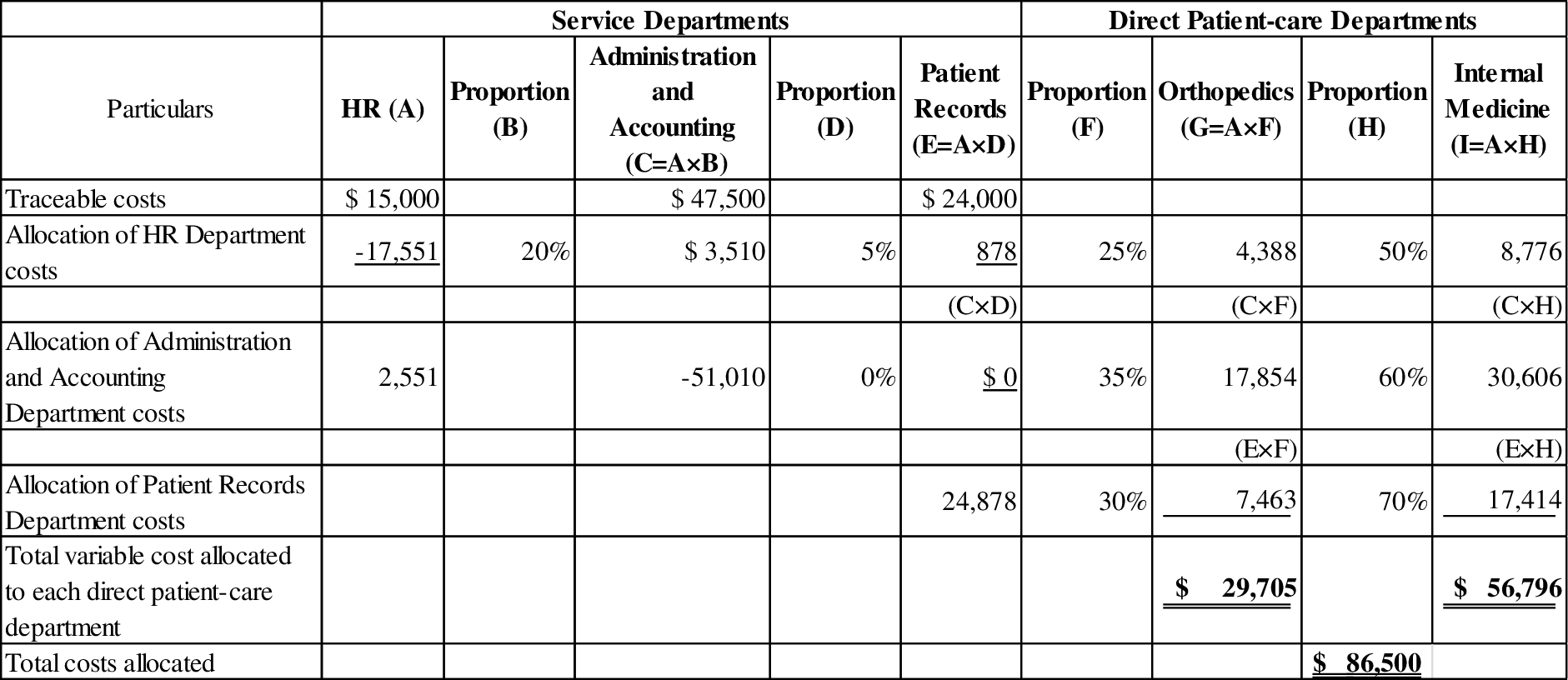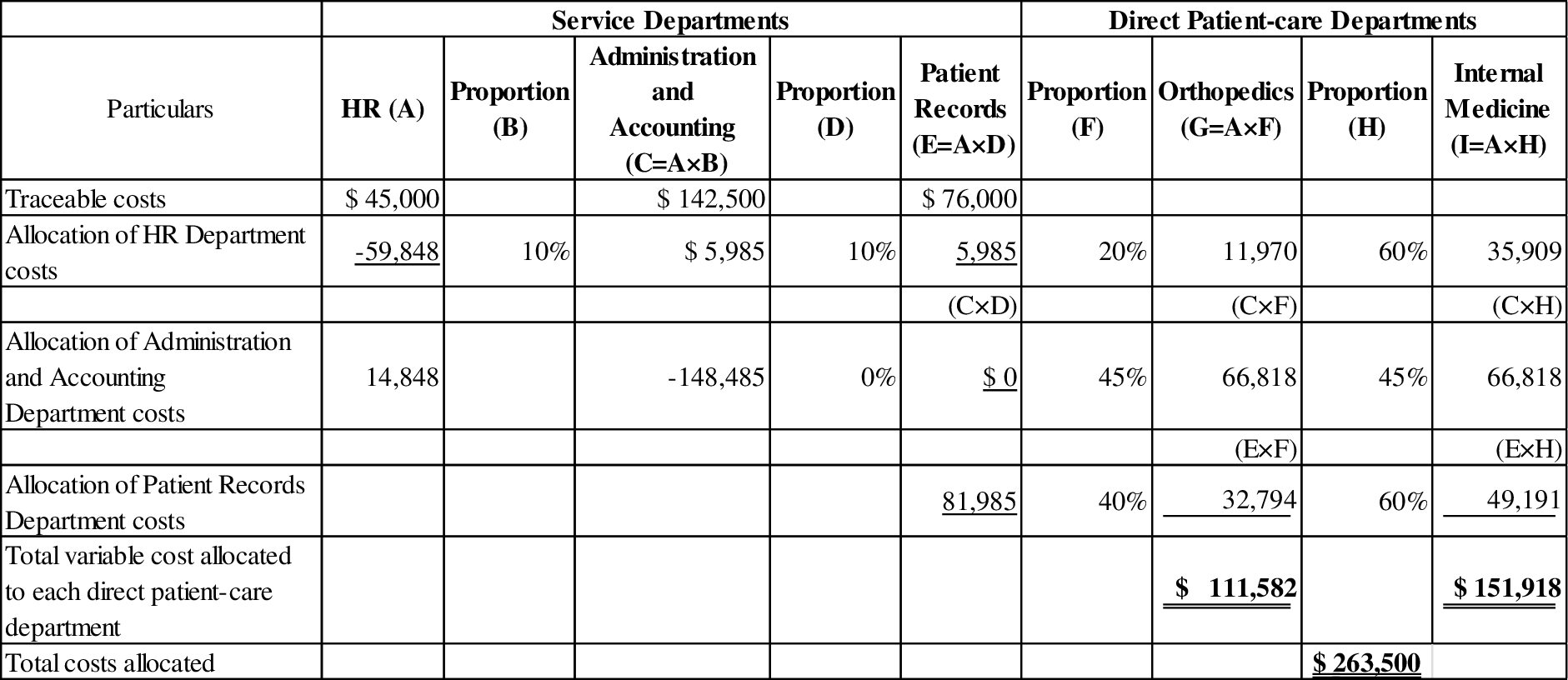
Allocate the service department costs of company R using the reciprocal-services method in combination with the dual-allocation approach.
Explanation of Solution
Reciprocal-services method: The term reciprocal service refers to the circumstances under which two or more service departments provide services to each other. Under this method, in order to reflect the reciprocal provision of services among all other service departments, a system of simultaneous equations is established. When once it is established, “all other service departments’ costs are allocated among the departments that use the various service departments’ output of services”. Moreover, this is the only cost allocation method that fully accounts for the reciprocal provision of services among departments.
Allocate the service department costs of company R using the reciprocal-services method in combination with the dual-allocation approach as follows:
Variable costs under short-run proportions:

Table (1)
Working note (1):
Assume that:
- The total variable cost of Human resources is denoted as H.
- The total variable cost of Administration and Accounting is denoted as A, and
- The total variable cost of patient records is denoted as R.
The equations are as follows:
Now, Substitute equation (3) in equation (2).
Then, Substitute the computed value of H in equation (1) and (3):
Equation (1):
Equation (3):
Fixed costs under long-run proportions:

Table (2)
Working note (2):
Assume that:
- The total variable cost of Human resources is denoted as H.
- The total variable cost of Administration and Accounting is denoted as A, and
- The total variable cost of patient records is denoted as R.
The equations are as follows:
Now, Substitute equation (6) in equation (5).
Then, Substitute the computed value of H in equation (4) and (6):
Equation (4):
Equation (6):
Total cost allocated:
| Particulars | Orthopedics | Internal Medicine |
| Variable costs | $ 29,705 | $ 56,796 |
| Add: Fixed costs | $ 111,582 | $ 151,918 |
| Total costs | $ 141,286 | $ 208,714 |
| Grand total | $350,000 | |
Table (3)
Want to see more full solutions like this?
Chapter 17 Solutions
Managerial Accounting: Creating Value in a Dynamic Business Environment
- Green Co. applies overhead at $10 per labor hour. It incurred $450,000 of actual overhead and reported $5,000 in overapplied overhead. How many direct labor hours were actually worked?arrow_forwardwhat should investors expect as a return on westbrook stock ?? general accountingarrow_forwardWhat is the amount of the net fixed assets?arrow_forward
- nonearrow_forwardIn business combinations under common control, goodwill is____. A. Calculated as in regular business combinations B. Amortized immediately C. Not recognized, difference goes to equity D. Always recognized at fair value MCQarrow_forwardWhat is the economic order quantity?arrow_forward
 Managerial AccountingAccountingISBN:9781337912020Author:Carl Warren, Ph.d. Cma William B. TaylerPublisher:South-Western College Pub
Managerial AccountingAccountingISBN:9781337912020Author:Carl Warren, Ph.d. Cma William B. TaylerPublisher:South-Western College Pub Principles of Cost AccountingAccountingISBN:9781305087408Author:Edward J. Vanderbeck, Maria R. MitchellPublisher:Cengage Learning
Principles of Cost AccountingAccountingISBN:9781305087408Author:Edward J. Vanderbeck, Maria R. MitchellPublisher:Cengage Learning Cornerstones of Cost Management (Cornerstones Ser...AccountingISBN:9781305970663Author:Don R. Hansen, Maryanne M. MowenPublisher:Cengage Learning
Cornerstones of Cost Management (Cornerstones Ser...AccountingISBN:9781305970663Author:Don R. Hansen, Maryanne M. MowenPublisher:Cengage Learning Managerial Accounting: The Cornerstone of Busines...AccountingISBN:9781337115773Author:Maryanne M. Mowen, Don R. Hansen, Dan L. HeitgerPublisher:Cengage LearningPrinciples of Accounting Volume 2AccountingISBN:9781947172609Author:OpenStaxPublisher:OpenStax College
Managerial Accounting: The Cornerstone of Busines...AccountingISBN:9781337115773Author:Maryanne M. Mowen, Don R. Hansen, Dan L. HeitgerPublisher:Cengage LearningPrinciples of Accounting Volume 2AccountingISBN:9781947172609Author:OpenStaxPublisher:OpenStax College Financial And Managerial AccountingAccountingISBN:9781337902663Author:WARREN, Carl S.Publisher:Cengage Learning,
Financial And Managerial AccountingAccountingISBN:9781337902663Author:WARREN, Carl S.Publisher:Cengage Learning,





